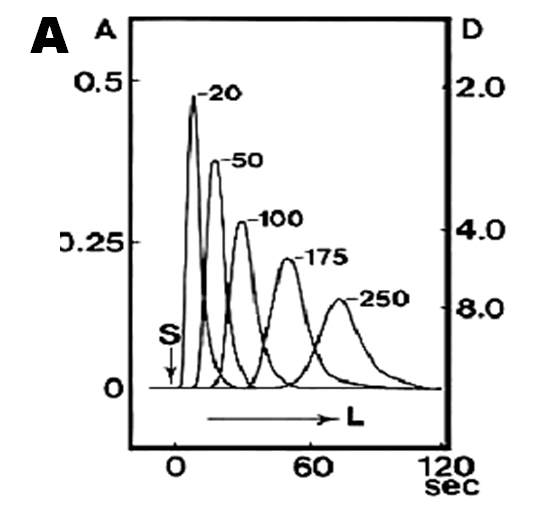Dispersion in a Single Line LOV
Reagent Volume
2.2.6.B.
On the way to the flow cell sample zone disperses into the surrounding reagent solution. As the length of the flow path (and its volume) increases, dispersion increases, peak height decreases and peak shape changes from asymmetrical to symmetrical while its base broadens. (Tanks in series model, Section 0.3.4.). At a constant flow rate, as used in Flow Injection, it is the length of the tubing (A) between injector and detector that controls the degree of sample dispersion and the incubation time available for chemical reactions. Therefore changing of sample dilution and of incubation time necessitates reconfiguration of manifold and thus the tools for optimization of assay are limited to changing length of tubing and of injected sample volume.
In miniaturized SIA format the LOV module is furnished with a tubular holding coil and the length (and volume) of the flow path is adjusted by changing the amplitude of the flow reversal used to inject reagent(s) into the holding coil. There are numerous ways which sample and reagents, their volumes, and their sequences can be combined to optimize reagent based assays (Sections 2.2.12. to 2.2.34.). The two sets of experiments presented here, are only meant to document the yet unrecognized efficiency of mixing accomplished by a single flow reversal, and a systematic investigation of this versatile approach still needs to be done. .
Similar to the experiment shown in a movie clip 2.2.5. a series of recordings were made, using blue dye as a sample and colorless diluent to simulate a reagent. Sample was aspirated into the holding coil, followed by reagent, the flow was reversed and the resulting peak was recorded. The runs obtained with the same injected sample volume (Sv 50 microliters Fig. B and Sv 100 microliters Fig. C), but increasing reagent volumes Rv are shown superimposed. The efficiency of mixing is documented by symmetry of peaks and decreasing peak height. Note that the initially injected undiluted dye ( Amax for Rv=0) is diluted almost to half when transported upstream by the double volume of reagent (Sv=50 using Rv=100 and Sv=100 using Rv=200). Also, when injecting equal volume of reagent ( Sv=50 using Rv=50 or Sv=100 using Rv=100) causes the 2nd peak to be 20% lower that the 1st one. Note, however, that dilution of the sample shown on these graphs is caused not only by reagent but also by the carrier solution initially present in the conduit.
Therefore the ratios of sample, reagent and carrier are visualized on the next page.











